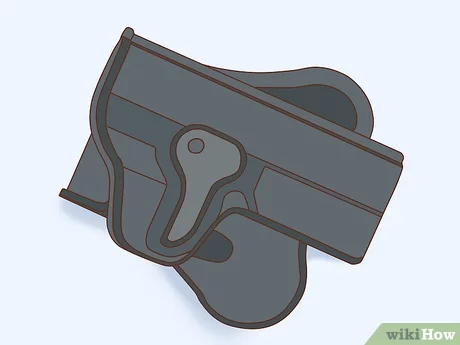
Paddle holsters are popular with plainclothes police officers and citizens who carry concealed. They are easy to adjust for position and use and provide convenient access.
However, these holsters may jostle when drawn or removed, making them less secure than other OWB holsters. What can you do to mitigate this?
Retention
Paddle holsters can be pretty convenient for those carrying firearms from their car to work and back again. When used properly with a proper-fitting gun belt, these holsters can hold your pistol in place securely while providing quick and easy access to it.
However, it is essential to remember that paddle holsters offer less retention than IWB holsters. These holsters typically offer only Level 1 retention. They have a securing strap or thumb break that holds the handgun in place within the holster and must be unsnapped or disengaged to draw your weapon.
This is why testing your holster is essential to ensure you can easily unlock and remove your gun without risking it falling off or being grabbed by someone else. Additionally, paddle holsters tend to push the firearm lower on your body than IWB holsters do. This can sometimes cause them to print visibly when wearing certain types of clothing.
Concealment
One of the primary benefits paddle holsters offer is their ease of concealment. They are designed to fit snugly against the belt seam and the body, making it hard for people to notice them. This makes them an excellent choice for people who want to keep their guns concealed but also have to take them out from time to time. For example, a detective who regularly takes their gun off for court appearances would benefit from the ability to holster and draw it quickly.
However, there may be better options than paddle holsters for everyday concealment. They are more likely to show under tighter clothing and can cause printing. Additionally, if you place a paddle holster over your tailbone, you run the risk of hurting yourself if you fall on it. To avoid this, consider a holster that mounts inside the waistband instead.
Adjustability
Paddle holsters are a great way to carry for those who wear their weapon inside the waistband (IWB). They don’t dig into your skin like IWB holsters, which can cause discomfort over long periods.
Most paddle holsters feature a ledge, lip, or hook to help secure them to the belt or waistline. This helps with friction and prevents the holster from being ripped off during an attempt at a gun grab. However, they lack the physical security of a belt holster that has the belt strapped through belt slots.
If you have a paddle holster, practice drawing from it several times before using it. You’ll want to ensure you can quickly and comfortably draw your handgun from it when needed—practice in various positions, from strong-side to appendix or even a 1 o’clock cant. A good holster can be adjusted for these various positions so you can find one that fits your needs.
Weight Capacity
While many holsters are not easily removed from the wearer, paddle-style holsters can be quickly and conveniently slid off. That fact is often a selling point to plainclothes police officers and other law enforcement professionals who carry concealed. It can also be helpful for armed citizens who wish to swap between firearms with minimal effort.
The ability to quickly remove and replace a firearm is beneficial for people who use their holsters daily. For example, a cop who regularly changes shifts can quickly stow their weapon in their patrol car and switch to the paddle holster when they return to the station.
However, a drawback of paddle holsters is that they can push the pistol further out from the body, which could pose an issue if you plan to conceal it under clothing. Therefore, it’s always important to practice drawing from a paddle-style holster several times before you decide to carry in this manner.




